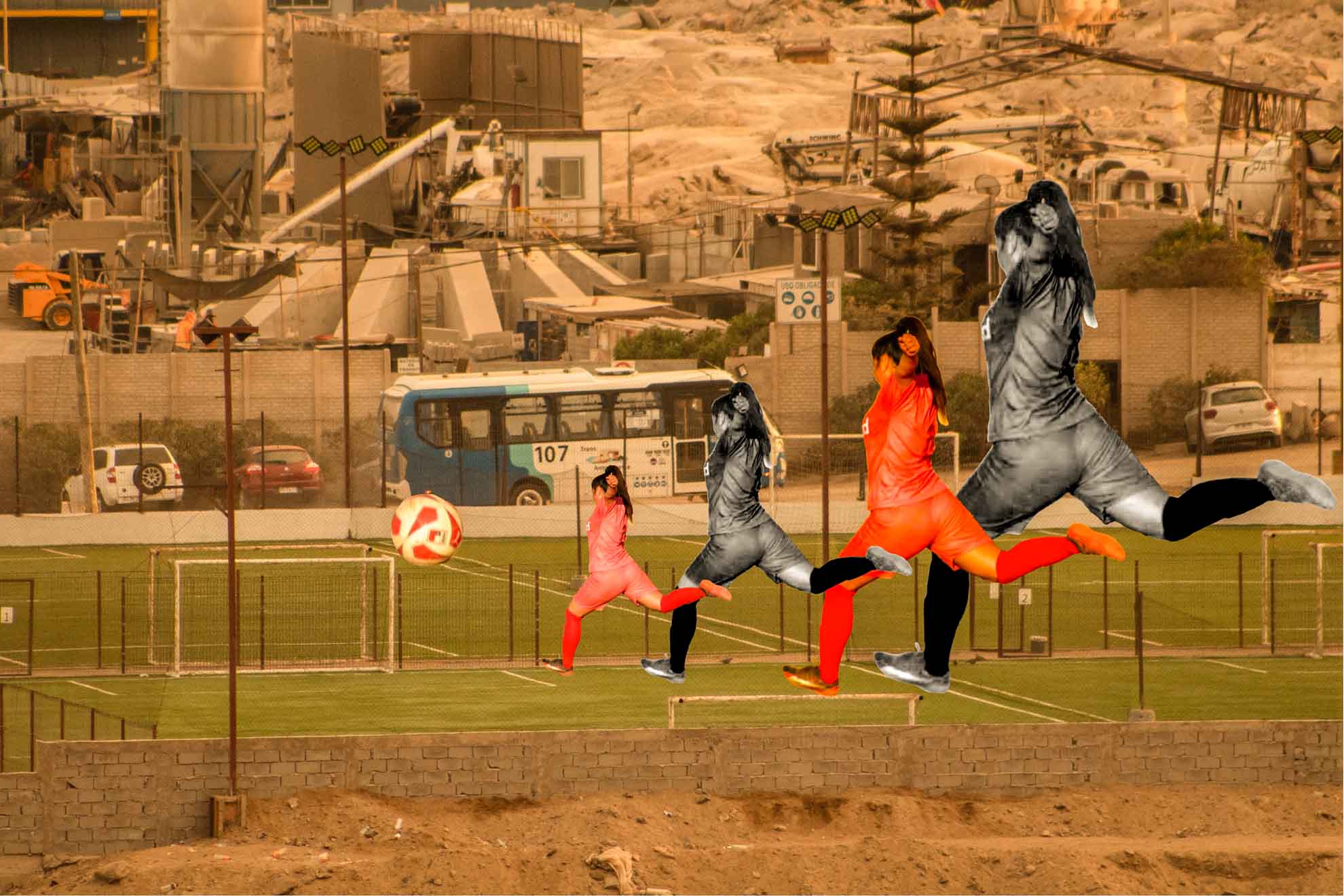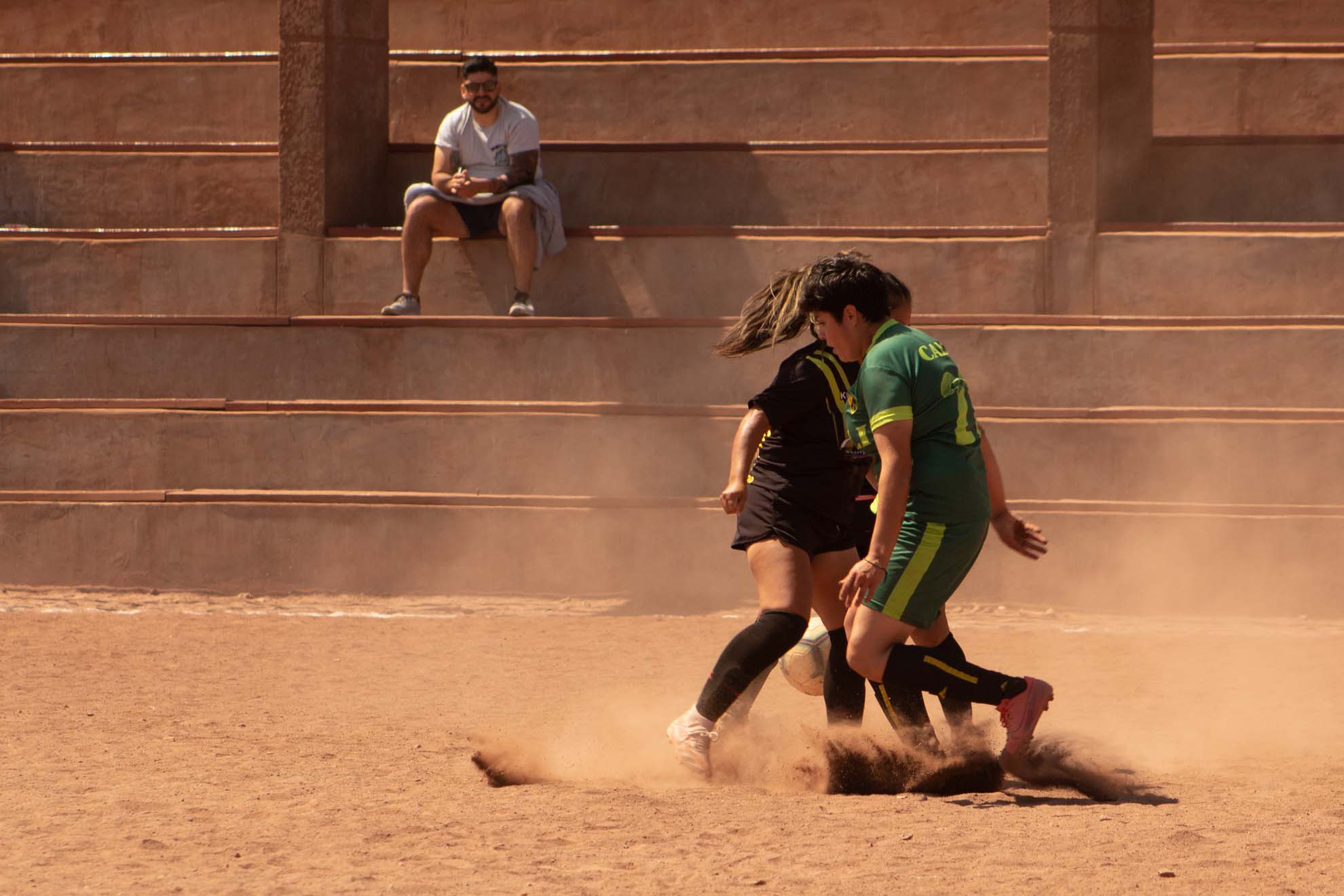
They seem to dance on the pitch
Santiago Wanderers is the oldest soccer team in Chile: they are called the Dean of Chilean soccer. In 2007, its women’s division was created, and only last year was it declared ‘professional.’ Manne Stoller’s daughter joined the team. Moved by her daughter’s passion, the photographer immersed herself in the world of women’s soccer and discovered stories of resistance, beauty, and rebellion, which she will include in her first documentary Decanas. Porteñas de Pasión Verde.
By Marcela Vallejo
On a winter Monday in 2019, the final of the Gold Cup championship was played in Valparaíso. That day there would be two matches in the María Eisler field, a land embedded in the Placeres hill that had been donated by one of the neighbors. Chilean photographer Maria Stoller was on site, accompanying the event.
The first match of the day was a men’s preliminary. Around the place was a soccer party with many men drinking beer, eating Choripan, and commenting on what was happening on the field. Half an hour before the end of the match, the atmosphere began to change: children arrived, and behind them came their families. The place was transformed, and the soccer party gave way to a family party. The women’s soccer final between the Sara Braun and Pedro Cabrera teams was about to begin.
The party was something else, “two-year-old kids were playing, it was already half past eight at night, and it was dark. It was winter.” The photographer says that there was a feeling of tranquility and warmth. As a photographer, she did not feel threatened, as she might have felt in an all-male environment.
“It has that warmth of women’s soccer to do the same thing that women have historically done: embrace and generate this space of tranquility,” says Stoller. For her, what happened that day is an example of women’s soccer’s strength: “it has to do with a beauty that seems to come from this will to make life despite all the historical resistance.”
Stoller says that photography has always been in her life since she was a child, but when her daughter decided to become a soccer player, photography took the place it is now. As her daughter strengthened her skills as a player, Stoller realized the importance of making visible what was happening. Because it wasn’t just about girls playing soccer: there was discrimination, inequality, and injustice. It was only last year that women’s soccer became professional in Chile. To raise her voice, to express herself, to denounce, but also to celebrate, Stoller found in her camera the ideal tool.
The photographer is preparing her first audiovisual documentary Decanas. Porteñas de Pasión Verde, in which she tells part of the story of the professionalization of the Santiago Wanderers women’s team and criticizes the fans. She also belongs to the Ibero-American collective Hinchas Reales Cuerpas Reales, which is interested in making visible “the passion of women and dissident fans of soccer clubs.” Last year, they participated in the annual call made by the Photography Center of Montevideo with an exhibition at the photo gallery El Prado.
Did you already have an interest in soccer, or is this something your daughter got you interested in alone?
The truth is that, in a sense, soccer makes fun of me a little bit. This story has been a way in which life has ironically made me see what I missed out. For me, soccer was a weekend nuisance. It was an invasion. There was nothing that soccer brought to me affectively.
But when I saw that what my daughter wanted more than anything in her life was to be a soccer player and the passion and the decision she had, everything changed. We started in 2017, and today she is part of the professional women’s training of Wanderers. That’s when I decided that I had to understand where she was; if this was going to be her world and I was going to accompany her, I decided that I had to do something about what she was going through. I decided that I didn’t want another girl to have to go through this again to do what she wants to do, and I have to say it loud and clear, that is, this is a right: the passion for doing something that moves your stomach cannot be subject to gender.
That’s when soccer and I reconciled and began to know all its dimensions from sociology, philosophy, and cinema. I began to understand why it was not only an imposition that seemed whimsical from a sporting point of view but also because we had been marginalized from the beginning of history.
The experience of accompanying your daughter in her process as a soccer player made you strengthen your relationship with photography. Along the way, you started the project Decanas. Porteñas de pasión verde a documentary about the women of Wanderers. What was it that pushed you so firmly?
When my daughter and I were introduced in 2017 to the dimension of women’s soccer in Chile, I was immersed in a new space. I began to surround myself with many violent situations from the resistance that they had to be permanently inhabiting them as professional players, as women, as athletes, and as families in the face of a reality that was ultimately upside down. I said, I have a tool that allows me to make visible and say what is happening, and I have to say it somehow, and I am here inside, so I spoke from photography, from the audiovisual I have to call attention to it.
That was the initial kick-off for what Decanas means today. It is the project that I started from this question and the need to understand how this dimension of soccer, which is so huge, had so many implications. It had to do with a pair of shoes that did not have the goats to play on the field and with a historical resistance in which women have been detached from the reality of social organization.
The question, installed in many different ways, pushed me to the need to make visible what was happening permanently and to understand, ask myself questions, and begin to investigate in various worlds. From there, photography became a tool, a trench.

The question you have worked with is about the place of women in soccer. What have you found?
In 2017, at the Valparaiso Photography Festival, I participated in the workshop of photographer Nicolás Janowski, and a personal project had to be raised in that city. I took women’s soccer hand in hand with the Wanderers fans, and from the question of how women were denied in that space, I began to inquire about the historical reality of Wanderers women in their city.
Santiago Wanderers is the oldest soccer team in Chile, the dean of Chilean soccer. The players until 2017 were called ‘Caturritas’; now they are called ‘Decanas.’
The passion and the work that the players have is the same, and the difference is in the rights that are made flesh when it comes to being social subjects. It was only last year that the milestone of the professionalization of women’s soccer in Chile was set.
So, I joined the Association of Chilean Football Researchers to investigate and look for new ways to vindicate women in soccer in Chile. Something that moved me was that people keep talking about these women following a fashion, even though women’s soccer has been played in Chile for over 100 years. There is a history that is submerged because the official media are male.
“Women’s soccer has a beauty that pushes me from photography to show the effort it possesses; it is a passion that seems to be able to do everything. Historically it has been and remains so. It is a strength we women have and is always feeding back. It doesn’t have this competitiveness to the death between men, but it is just as passionate and has its complexities.”
You mention that soccer led you to investigate several worlds. What were they?
When I identified the need for tracking or information surveys that vindicate our position in this sport, I found another space for dissemination in the cinema. So I became part of the Festigol team, Film + Soccer Festival, and last year we created a poster celebrating the milestone of the professionalization of women’s soccer. We also discussed soccer and resistance in spaces of social coexistence dynamics. We were interested in valuing the importance of these organized women generating social fabric in their areas despite all the negligence of the state.
Cinema has been a resource to roar that this exists, that we are here, that there is dissident soccer, and that this soccer is virtuous because it generates this social fabric. In addition, it revolutionizes the social spaces where it is installed; it generates new ways of communicating, associating, and creating society.
From photography and research, I joined the Cuerpos Reales, Hinchas Reales (Real Bodies, Real Fans) collective also to make Wanderer women visible.
There is a criticism of soccer, probably from people who are not interested but who see soccer as just that: men playing on a field. They may not see all this social fabric you mention and for which there are interesting examples.
In soccer, the market has eaten everything. We have a smokescreen over the situation; politically, it should be a bit like that. Here in Chile today, if you ask me how to make a country reconnect after all the things that have happened socially, how to get closer again and meet again, to get out not only of virtuality but of that intrinsic selfishness in which we are all separated. We care little, and to regain that social fabric is precisely in sports activities and in the sports venues of neighborhood clubs.
Nobody says no to a Pichanga. It is fundamental but genuine: who can resist sharing time in a space where it doesn’t matter how you play because you will enjoy the possibility of sharing?
People do not see all this because they are left with the image of Alexis Sanchez: success and excessive consumption, that aspirational image that may be nice, but if we take it down to the real world, it is far from what is happening to us and how we live our lives. So there is a repudiation of the image of this soccer that has no soul.
In that sense, what can we learn from women’s soccer, not only on the field but with everything surrounding it?
Women’s soccer has a beauty that pushes me from photography to show the effort it has in itself. First of all, it has a passion that seems to be able to do everything; historically, it has been like that, and it remains like that. It is like that strength that women seem to have and that we are permanently feeding back.
It does not have this competitiveness to the death that exists among men, but it is just as passionate, super intense, and has its complexities. It also has to do with this energy, which is feminine and independent of what we are talking about; there are also dissidents playing, and many different dynamics are developing. Even when playing at the level of mixed soccer organized by women, the dynamics inside the field are different.
Pedro Carcuro, a well-known commentator here in Chile, talks about the dance of soccer. The women dance behind the ball, and it generates a different rhythm. This feminist discourse, if you will, for me, is a discourse of resistance that can be seen in everything. It fills everything. It’s like a hymn to life. That’s what women’s soccer is all about.


